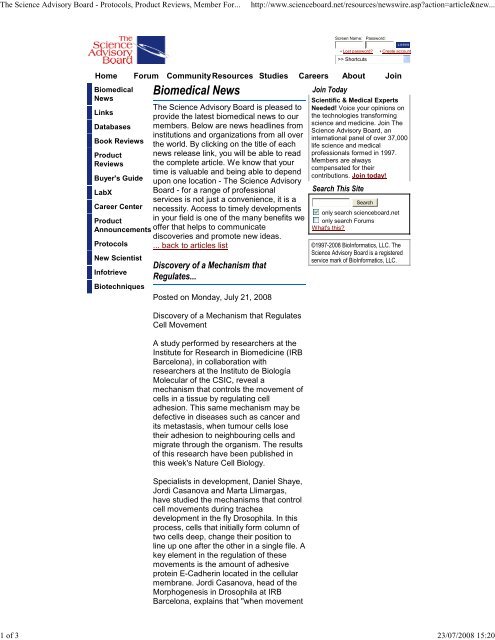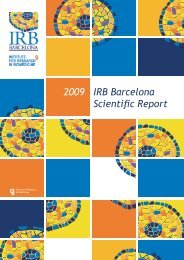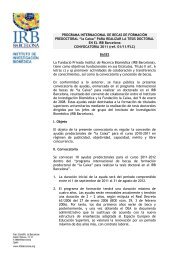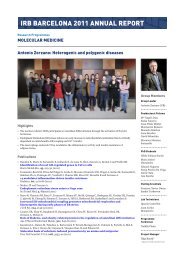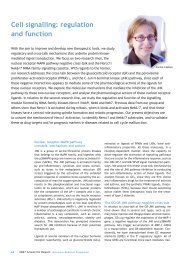The Science Advisory Board (PDF) - IRB Barcelona
The Science Advisory Board (PDF) - IRB Barcelona
The Science Advisory Board (PDF) - IRB Barcelona
Create successful ePaper yourself
Turn your PDF publications into a flip-book with our unique Google optimized e-Paper software.
<strong>The</strong> <strong>Science</strong> <strong>Advisory</strong> <strong>Board</strong> - Protocols, Product Reviews, Member For...<br />
http://www.scienceboard.net/resources/newswire.asp?action=article&new...<br />
1 of 3 23/07/2008 15:20<br />
Screen Name: Password:<br />
• Lost password?<br />
>> Shortcuts<br />
• Create account<br />
Home Forum CommunityResources Studies Careers About Join<br />
Biomedical<br />
News<br />
Links<br />
Databases<br />
Book Reviews<br />
Product<br />
Reviews<br />
Buyer's Guide<br />
LabX<br />
Career Center<br />
New Scientist<br />
Infotrieve<br />
Biotechniques<br />
Biomedical News<br />
<strong>The</strong> <strong>Science</strong> <strong>Advisory</strong> <strong>Board</strong> is pleased to<br />
provide the latest biomedical news to our<br />
members. Below are news headlines from<br />
institutions and organizations from all over<br />
the world. By clicking on the title of each<br />
news release link, you will be able to read<br />
the complete article. We know that your<br />
time is valuable and being able to depend<br />
upon one location - <strong>The</strong> <strong>Science</strong> <strong>Advisory</strong><br />
<strong>Board</strong> - for a range of professional<br />
services is not just a convenience, it is a<br />
necessity. Access to timely developments<br />
in your field is one of the many benefits we<br />
Product<br />
Announcements offer that helps to communicate<br />
discoveries and promote new ideas.<br />
Protocols ... back to articles list<br />
Discovery of a Mechanism that<br />
Regulates...<br />
Posted on Monday, July 21, 2008<br />
Discovery of a Mechanism that Regulates<br />
Cell Movement<br />
A study performed by researchers at the<br />
Institute for Research in Biomedicine (<strong>IRB</strong><br />
<strong>Barcelona</strong>), in collaboration with<br />
researchers at the Instituto de Biología<br />
Molecular of the CSIC, reveal a<br />
mechanism that controls the movement of<br />
cells in a tissue by regulating cell<br />
adhesion. This same mechanism may be<br />
defective in diseases such as cancer and<br />
its metastasis, when tumour cells lose<br />
their adhesion to neighbouring cells and<br />
migrate through the organism. <strong>The</strong> results<br />
of this research have been published in<br />
this week's Nature Cell Biology.<br />
Specialists in development, Daniel Shaye,<br />
Jordi Casanova and Marta Llimargas,<br />
have studied the mechanisms that control<br />
cell movements during trachea<br />
development in the fly Drosophila. In this<br />
process, cells that initially form column of<br />
two cells deep, change their position to<br />
line up one after the other in a single file. A<br />
key element in the regulation of these<br />
movements is the amount of adhesive<br />
protein E-Cadherin located in the cellular<br />
membrane. Jordi Casanova, head of the<br />
Morphogenesis in Drosophila at <strong>IRB</strong><br />
<strong>Barcelona</strong>, explains that "when movement<br />
Join Today<br />
Scientific & Medical Experts<br />
Needed! Voice your opinions on<br />
the technologies transforming<br />
science and medicine. Join <strong>The</strong><br />
<strong>Science</strong> <strong>Advisory</strong> <strong>Board</strong>, an<br />
international panel of over 37,000<br />
life science and medical<br />
professionals formed in 1997.<br />
Members are always<br />
compensated for their<br />
contributions. Join today!<br />
Search This Site<br />
Search<br />
only search scienceboard.net<br />
only search Forums<br />
What's this?<br />
©1997-2008 BioInformatics, LLC. <strong>The</strong><br />
<strong>Science</strong> <strong>Advisory</strong> <strong>Board</strong> is a registered<br />
service mark of BioInformatics, LLC.
<strong>The</strong> <strong>Science</strong> <strong>Advisory</strong> <strong>Board</strong> - Protocols, Product Reviews, Member For...<br />
http://www.scienceboard.net/resources/newswire.asp?action=article&new...<br />
2 of 3 23/07/2008 15:20<br />
starts, the levels of this protein in the cells<br />
decrease, thereby allowing them to slide<br />
one on top of the other, and once in this<br />
position the levels of this protein are<br />
re-established in order to seal the new<br />
binding alignment". <strong>The</strong> in-depth study of<br />
this phenomenon has led to the finding<br />
that the amount of E-Cadherin on the cell<br />
surface is controlled by the trafficking of<br />
this protein inside the cell and the<br />
identification of the elements that regulate<br />
this transport. During the experiments, the<br />
researchers induced or blocked cell<br />
movement by modifying the elements that<br />
control the trafficking of adhesive protein<br />
towards the membrane. "We demonstrate<br />
a mechanism that explains how cells can<br />
change their position within a given tissue.<br />
<strong>The</strong> sequence is clear: the greater the<br />
amount of protein, the greater the<br />
adhesion and the smaller the movement",<br />
recaps Casanova.<br />
A mechanism may be dysfunctional during<br />
cancer progression and metastases<br />
<strong>The</strong> role of E-Cadherin in the binding<br />
between epithelial cells is universal in all<br />
animals and therefore, following logic, the<br />
researchers believe that the mechanisms<br />
that regulate the levels of this protein may<br />
also be universal. "We speculate that the<br />
regulatory mechanism that we have<br />
discovered may also be present in other<br />
developmental contexts. However, in<br />
addition, fundamental elements of the<br />
mechanism may show a dysfunction in<br />
pathological processes such as the<br />
progression of cancer and metastases",<br />
adds Casanova. As revealed by this same<br />
researcher, the amounts of E-Cadherin<br />
and of one of the elements required for<br />
trafficking decrease in the progression of a<br />
kind of oesophagus cancer and this effect<br />
is related to the gain in tumour cell motility,<br />
which allows them to spread throughout<br />
the body more rapidly.<br />
Thanks to this study, researchers working<br />
on cancer will be able to use animal<br />
models to test whether this mechanism is<br />
defective in other kinds of tumours and to<br />
study whether any of its genetic<br />
components are valid as therapeutic<br />
targets.<br />
***<br />
This news provided by EurekAlert!, an<br />
online press service created by the
<strong>The</strong> <strong>Science</strong> <strong>Advisory</strong> <strong>Board</strong> - Protocols, Product Reviews, Member For...<br />
http://www.scienceboard.net/resources/newswire.asp?action=article&new...<br />
3 of 3 23/07/2008 15:20<br />
American Association for the<br />
Advancement of <strong>Science</strong> (AAAS).


